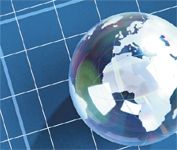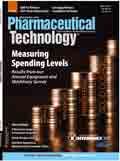A Focus on Emerging Markets
The power of emerging markets is reflected in the pharma's sales and production positions.
Numbers don't lie, goes the saying, and this axiom is borne out when reviewing the 2010 financial results of the pharmaceutical majors and their performance in emerging markets. Facing slowing or declining growth in the United States and Western Europe, growth in emerging markets was the strong suit for Big Pharma in 2010.

(IMAGE: GETTY IMAGES)
Crunching the numbers
The pharmaceutical industry's focus on emerging markets stems from strong growth projections, which outpace overall pharmaceutical-industry growth. In 2011, the value of the global pharmaceutical market is expected to grow 5–7% to $880 billion, according to October 2010 estimates by IMS Health, improving from 2010 industry growth of 4–5%. Seventeen so-called pharmerging countries, as defined by IMS, are forecast to grow at a 15–17% rate in 2011 to $170–180 billion. China's pharmaceutical market, which is predicted to grow 25–27% to more than $50 billion in 2011, is currently the world's third-largest pharmaceutical market.

Patricia Van Arnum
Company results
Big Pharma's recent sales reflect the strength of emerging markets. Pfizer, the largest global pharmaceutical company, reported 2010 biopharmaceutical sales of $58.52 billion compared with 2009 sales of $45.45 billion, a 29% gain compared with 2009 sales and reflective of Pfizer's 2009 acquisition of Wyeth. In 2010, pharmaceutical sales to emerging markets accounted for 14.8% of Pfizer's sales, or $8.66 billion, a 41% gain over 2009, when the company's emerging-market sales were $6.16 billion. For purposes of the company's reporting, emerging market sales include sales to Asia (excluding Japan and South Korea), Latin America, the Middle East, Africa, Central and Eastern Europe, Russia, and Turkey.
Pfizer's two largest-selling products overall were also its bestsellers in emerging markets. The anticholesterol drug Lipitor (atorvastatin), Pfizer's top-selling drug, had sales of $923 million in emerging markets, accounting for 8.6% of Lipitor's overall 2010 global sales of $10.73 billion. The anti-arthritis/autoimmune drug Enbrel (etanercept) posted sales of $629 million in emerging markets, accounting for 19.2% of Enbrel's total sales of $3.27 billion.
Emerging markets generated in excess of EUR 9 billion ($12.2 billion) in 2010 sales for sanofi-aventis, a 16.3% increase compared with 2009 sales. Emerging markets accounted for 29.9% of the company's total sales in 2010, making this segment the largest contributor to its group sales by region. In 2010, sanofi's pharmaceutical sales (i.e., prescription drug, consumer healthcare products, and generic drugs) to emerging markets were EUR 7.69 billion ($10.43 billion), an 11.9% increase over 2009 levels. Its pharmaceutical sales to Western Europe, however, fell 8.5% to EUR 8.72 billion ($11.83 billion), and US sales fell 7.5% to EUR 7.01 billion ($9.51 billion). Vaccine sales to emerging markets were EUR 1.39 billion ($1.89 billion), up 46.2% over 2009 levels. Vaccine sales to Western Europe declined 15.6% to EUR 282 million ($382 million), and US vaccine sales declined 11.5% to EUR 1.96 billion ($2.66 billion).

DCAT Week
In an EuroBusinessMedia interview in February 2011, Chris Viehbacher, CEO of sanofi-aventis, emphasized the importance of emerging markets. "Emerging markets really [are] becoming a strength of the company. Imagine a business: EUR 9 billion, it's growing at double-digit rates, we got close to 19,000 reps, close to 40,000 employees, there are 38 plants that can produce at lower cost, there are businesses where we have been for decades, so we have got depth of management, understanding of customers, we have a product portfolio that manages that," he said in a transcript posted on sanofi's website. "And what no other company in this industry can say, in 2010, we sold more in emerging markets than either of the US or Europe."
In 2010, Novartis reported pharmaceutical sales of $30.6 billion, an increase of 6% in constant currencies year over year. Europe remained the country's largest pharmaceutical market, as sales increased 7% in constant currencies to $10.9 billion. US sales increased 5% in constant currencies to $10.0 billion. In 2010, pharmaceutical sales (excluding sales from its recent acquisition of the ophthalmic drug company Alcon) in China, Russia, Brazil, India, South Korea, and Turkey were $2.9 billion, a 9% gain compared with 2009 sales, led by double-digit growth in India, Russia, South Korea, and China, which offset cost-containment measures in Turkey. Pharmaceutical sales to Latin America and Canada were $2.9 billion, up 14% year over year.
Emerging markets are part of Glaxo-SmithKline's (GSK) strategy to improve its return on investment and capital allocation and to decrease its dependency on what the company terms "white pills/Western markets," said GSK CEO Andrew Witty, in a Feb. 3, 2011, company press release. White pills/Western markets refers to sales of tablets and simple injectables (excluding biopharmaceuticals and vaccines) in North America and Europe. Sales generated from these markets and products have decreased from 40% of overall revenues in 2007 to 25% in 2010, according to the GSK release.
In 2010, GSK's pharmaceutical sales from emerging markets increased 22% to £3.6 billion ($5.8 billion), led by 20% sales growth for Valtrex (valacyclovir), a drug to treat shingles and herpes, and the antidiabetes drug Avandia (rosiglitazone). In contrast, European pharmaceutical sales declined 6% to £6.5 billion ($10.5 billion), primarily due to lower sales from pandemic-influenza products, generic competition for Valtrex, and lower sales of Avandia. US pharmaceutical sales fell 11% to £7.6 billion ($12.2 billion) due to generic competition for Valtrex and lower sales of Avandia and pandemic influenza-related products. On a therapeutic basis, GSK's strongest sales to emerging markets were vaccines (£927 million, or $1.5 billion), respiratory drugs (£616 million, or $992 million), and antibacterials (£609 million, or $980 million). As might be expected, operating margins for pharmaceutical sales in emerging markets were lower compared with those from developed markets. GSK had an operating margin of 35.7% for pharmaceutical sales in emerging markets compared with a 65.9% operating margin for US pharmaceutical sales and a 57.2% operating margin for European pharmaceutical sales.

Formulation development forum: intelligent medicines
Roche's pharmaceutical sales declined 2% in local currencies to CHF 37.1 billion ($38.7 billion). Sales in international markets (i.e., Asia Pacific, excluding Japan, Central and Eastern Europe, the Middle East, Africa, Central Asia, Indian subcontinent, Latin America, and Canada) were CHF 9.2 billion ($9.6 billion), an 8% increase in local currencies, representing 25% of Roche's pharmaceutical sales, a level commensurate with pharmaceutical sales to Western Europe. Roche noted strong growth in Latin America (20%), led by Brazil and Venezuela, and solid growth in the Asia-Pacific region (8%), led by China and Taiwan. Roche's bestsellers internationally were the anticancer therapy Herceptin (trastuzumab) and the autoimmune drug MabThera/Rituxan (rituximab) with sales of CHF 1.5 billion ($1.6 billion) and CHF 1.4 billion ($1.5 billion), respectively.
Roche's US pharmaceutical sales, its largest market with a 38% share, fell 1% to CHF 14.1 billion ($14.7 billion). Pharmaceutical sales to Western Europe, which accounted for 25% of its 2010 pharmaceutical sales, declined 5% to CHF 9.5 billion ($9.9 billion). Pharmaceutical sales to Japan, which accounted for 12% of Roche's sales in 2010, fell 12% to CHF 4.3 billion ($4.5 billion).
AstraZeneca reported strong growth in emerging markets, which offset declining US sales. AstraZeneca had 2010 pharmaceutical sales of $33.27 billion, in part reflecting a 7% decline in the US to $13.73 billion. Sales to emerging markets increased 15% to $5.20 billion, which represented the first time that the company exceeded sales growth of $5 billion in emerging markets. Revenue in China increased 28% to $1.05 billion, and sales to other emerging Asia-Pacific countries increased 7% to $890 million. Sales to other emerging markets (i.e., Brazil, India, Mexico, Russia, Turkey, and other countries) increased 20% to $2.10 billion. Sales to emerging markets increased 6% yo $1.17 billion. In contrast, pharmaceutical sales to Western Europe increased only 2% to $9.25 billion, and sales to the established rest-of-world markets (i.e., Canada, Japan, Australia, and New Zealand) increased 7% to $5.18 billion. AstraZeneca's top-selling therapeutic areas in emerging markets were cardiovascular ($1.74 billion), gastrointestinal ($874 million), oncology ($843 million), respiratory ($762 million), and neuroscience ($650 million).
Bristol-Myers Squibb had net sales of $19.48 billion in 2010, a 4% increase compared with 2009, when it reported sales of $18.81 billion. The US accounted for approximately 65% or $12.61 billion of its 2010 sales. At a UBS Healthcare conference in September 2010, Beatrice Calaza, senior vice-president of commercial operations and president of global commercialization for Europe and emerging markets, emphasized that the company's emerging-market growth strategy is aligned to the company's overall biopharmaceutical strategy and is focused on five emerging markets: China, Brazil, Russia, Turkey, and India. BMS historically has had modest sales to emerging markets. No single country outside the US contributed more than 10% of the company's total net sales in 2009, 2008, or 2007. The combined net sales in emerging markets approximated 4% of total net sales in 2009 and 2008 and 3% in 2007.
Abbott had worldwide pharmaceutical sales of $19.89 billion in 2010. International sales represented 56% of its pharmaceuticals sales, or $11.15 billion, and US sales accounted for 44% or $8.74 billion. International pharmaceutical sales increased 28.3% in 2010 compared with 12.2% growth for US pharmaceutical sales, in part due to the company's acquisition of the pharmaceutical business of Solvay Pharmaceuticals in February 2010 and the domestic formulation business of India's Piramal Healthcare Solutions in September 2010.
Other companies showed mixed results. Johnson & Johnson reported pharmaceutical sales of $22.40 billion, a 0.6% decline compared with 2009 sales. US pharmaceutical sales decreased 4% to $12.52 billion, and international sales increased 4.2% to $9.88 billion. In 2010, Eli Lilly reported global pharmaceutical revenue of $21.68 billion, accounting for the majority of its total sales of $23.10 billion, which included sales in its animal-health business of $1.39 billion. Overall sales increased 6% in 2010 compared with 2009. US revenues increased 5% to $12.87 billion, and revenues outside the US increased 7% to $10.21 billion. Merck & Co. reported pharmaceutical sales (human health and consumer healthcare products) in 2010 of $39.81 billion and did not break out sales to emerging markets in its 2010 earnings release.
Patricia Van Arnum is a senior editor at Pharmaceutical Technology, 485 Route One South, Bldg F, First Floor, Iselin, NJ 08830tel. 732.346.3072, pvanarnum@advanstar.com.

Drug Solutions Podcast: A Closer Look at mRNA in Oncology and Vaccines
April 30th 2024In this episode fo the Drug Solutions Podcast, etherna’s vice-president of Technology and Innovation, Stefaan De Koker, discusses the merits and challenges of using mRNA as the foundation for therapeutics in oncology as well as for vaccines.
Drug Solutions Podcast: Applying Appropriate Analytics to Drug Development
March 26th 2024In this episode of the Drug Solutions Podcast, Jan Bekker, Vice President of Business Development, Commercial and Technical Operations at BioCina, discusses the latest analytical tools and their applications in the drug development market.